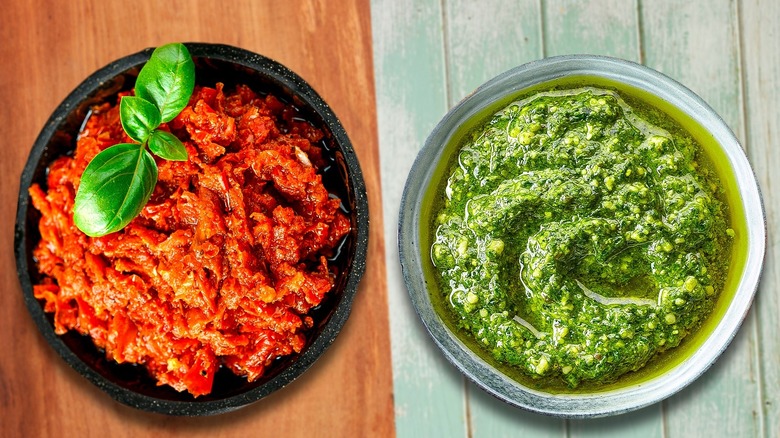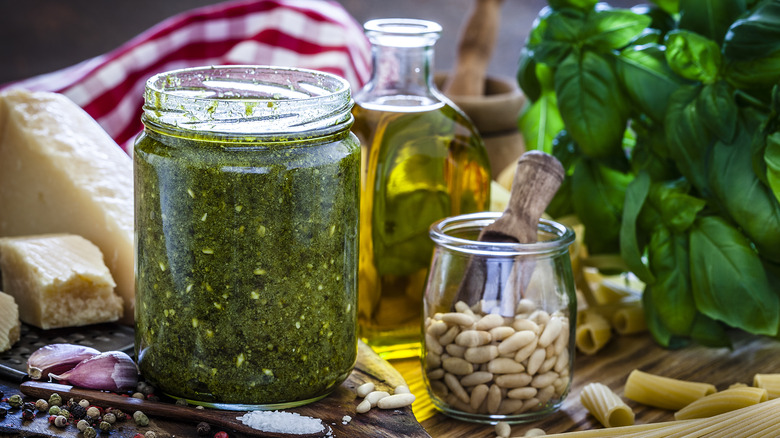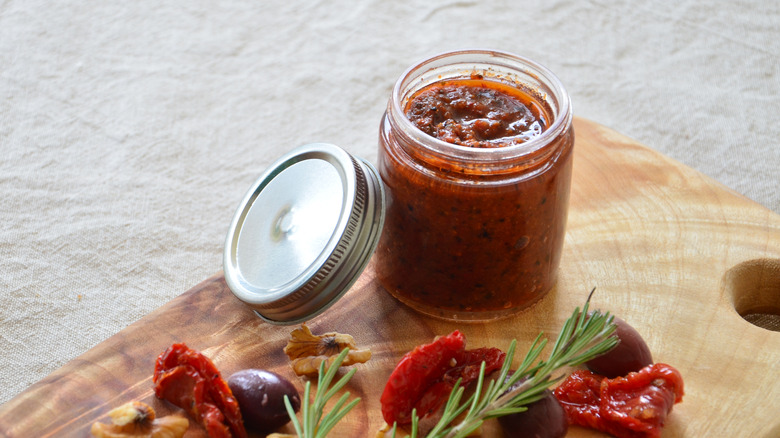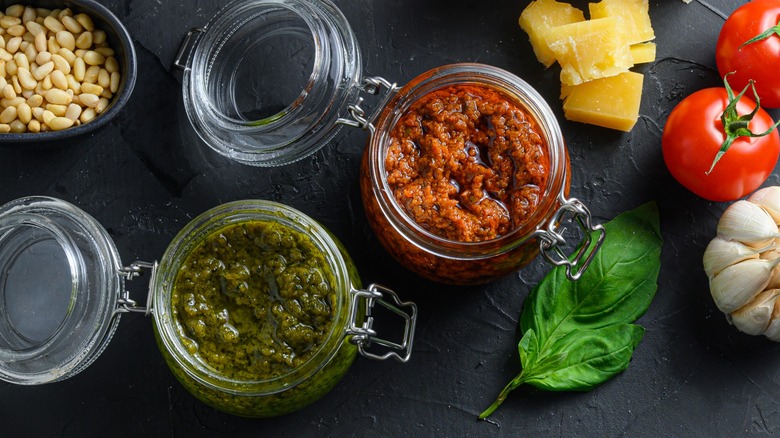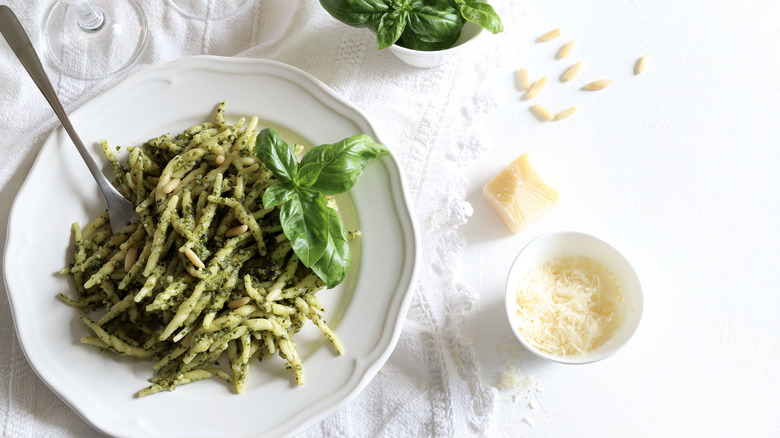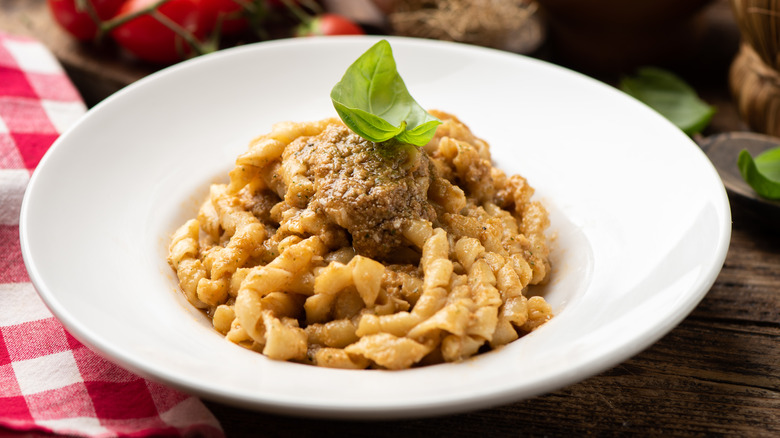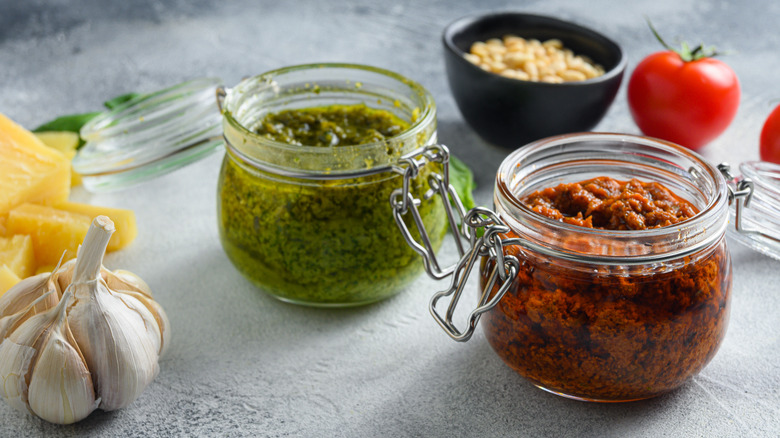The Difference Between Red And Green Pesto Goes Beyond Color
Pesto is a wonderful sauce to make, not just because of how packed with flavor it is but also because of how wonderful the kitchen smells after. An Italian food item with a history that goes back to the ancient Roman era, people love its herbaceous taste and aroma, which not only elevates pasta dishes but also tastes great on pizza and with chicken, fish, and roasted vegetables. It has such a universal appeal that folks tend to call any sauce that's made by blending green herbs, oil, and spices together pesto. The original, however, is pasta alla Genovese.
There's another type of pesto sauce that also comes from Italy, albeit from a region different from the one that created the classic green version. Red pesto is also known as pesto alla Trapanese, named after the Trapani town in Sicily, although you'll also see it called tomato pesto. It's equally versatile in the kitchen, serving as an all-around sauce suitable for pasta, pizza, sandwiches, chicken, fish, and veggies.
Given the emphasis that Italian food culture places on authenticity and the use of traditional methods and ingredients, any lover of the country's cuisine must learn how each pesto type is unique from the other. Aside from the obvious difference in color, both sauces were developed using produce that their respective regions are known for. Learn how this contributes to the flavor of each pesto variety, so you'll know which sauce to reach for the next time you're craving a tasty, saucy dish.
What is green pesto?
Classic green pesto originates from Genoa, Italy. Since it's prepared by breaking down the main ingredients — pine nuts, basil, and garlic — with a mortar and pestle, the sauce was named after "pestare," the Genovese word for "to crush." Olive oil is added to the mixture to turn it into a paste, and then cheese is stirred in for even more flavor.
Pesto evolved from another sauce that was also made by pounding ingredients together. Called agliata, it was made by crushing garlic and bread and mixing them with vinegar. In 1200 A.D., agliata was used by Genovese sailors as a preservative and condiment for the dried meat they consumed during the long months while they were out at sea. Through the centuries, the Genovese people gradually substituted most of the original ingredients to come up with the green sauce that the world now knows and loves.
Because of its global appeal, traditional pesto also gets its share of modifications. Sometimes, basil is used with mint and other greens to make pesto, and substitutes are also used in place of pine nuts when they're not available. While cheese from Parma and Sardinia is used in the classic recipe, chefs and home cooks have shifted to more accessible cheeses like Pecorino Romano to make the sauce. There are even versions of pesto that swap specific ingredients for alternatives that are healthier for people with nut allergies.
What is red pesto?
Red pesto similarly evolved from agliata, which Genovese sailors would bring to the coastal city of Trapani whenever they would make a stop there. Agliata became known as pasta cu l'Agghia pistata, or pasta with garlic, among the Trapani locals. Soon, they also began incorporating locally available ingredients into it. Since Sicily is abundant in almonds, these are used rather than pine nuts. Ripe tomatoes were also added to the sauce, giving it a vibrant red hue. These modifications added extra steps to the recipe: the almonds must be blanched and the tomatoes peeled and seeded before they're mixed with the pulverized garlic and salt. The result of this evolved version is what is now known as pesto alla Trapanese.
Since it's made with tomatoes, red pesto has a delicious acidity not found in green pesto. The recommended tomato variants for this dish are the smaller perino and cherry tomatoes, although San Marzano and Roma tomatoes are also good choices because of their natural sweetness. Some of this pesto's variations that are found in other areas of Sicily have a more intense flavor to them because they're made with more potent-tasting sun-dried tomatoes. There are also recipes that add roasted red bell peppers to the mix to heighten the sauce's color and sweetness.
Green pesto has a fresh, herbaceous flavor while red pesto tastes richer
The switch in the ingredients used to make red pesto creates not just a stark difference in color but in taste, too. As we mentioned, red pesto has a sweet and tart flavor profile that tastes richer than green pesto. Green pesto, meanwhile, is nutty, salty, and herbaceous, with an earthy flavor. The green variant has always incorporated cheese, with traditional Genovese recipes calling for either Parmigiano Reggiano or Pecorino Fiore Sardo. The latter is a Sardinian product made of sheep's milk, with a slightly sweet and smoky taste that balances the flavors of basil, garlic, and pine nuts.
In comparison, the classic version of red pesto skips the cheese, although modified recipes outside of Sicily now incorporate pecorino into them. Ricotta salata is also an option if you want to lift your pesto alla Trapanese with subtle salty notes.
Although they taste different, favoring one over the other is a matter of personal preference. They can both be used to give meaty roasts a burst of freshness, courtesy of the minty undertones found in basil. You make your choice depending on whether you want your dish to have an herby brightness or that sweet and tangy contrast.
Green pesto is traditionally paired with trofie
In their places of origin, both pesto varieties are served with a specific kind of pasta. The Genovese like theirs tossed with trofie — short, thin strands of noodles twisted to create ridges for the sauce to cling to. This makes sure every forkful of pasta is packed with that signature herby taste.
According to the local lore in Recco, a town near Genova where trofie was first made, it got its shape from the women who would make spirals out of pasta pieces by rolling the dough on their knees as they sat along the coast, waiting for their husbands to come home from fishing. The rubbing action that creates the twisted shape is called strufuggia in the Genovese dialect, hence the name of the pasta.
An unconventional pasta shape that more people should use in their cooking, trofie is made with durum wheat flour, salt, and water. There's another variant of this pasta called trofie bastarde, which uses chestnut flour to give it a sweeter taste. Although its strands are short and thin, trofie has a dense and delightfully chewy texture, making it the perfect starchy companion to green pesto's potent flavor.
Red pesto is traditionally paired with busiate
Red pesto, on the other hand, is preferred by Sicilians to be tossed with freshly cooked busiate, and their combination results in one of the best Sicilian pasta dishes to try. A pasta that features similarly twisted strands as trofie, busiate is made using only durum wheat semolina flour and water. Flour made with Sicilian heritage grains such as tumminia is used by those who prefer low-gluten pasta.
Busiate is made by flattening the dough and cutting it into narrow strips. Each strip is then wrapped diagonally around a metal rod. Today, pasta-makers in Trapani use a tool called ferretto, but historically, people would twirl the dough around a knitting needle called a busa. This method of twisting makes the spirals in busiate slightly looser and bigger than trofie's, leaving a hollow section inside. It's also cut longer than the latter, making it easier to twirl around a fork. Busiate's shape, length, and internal cavity make it the perfect vehicle for scooping up as much red pesto as possible with every forkful.
Both green and red pesto must be served fresh
Freshly made pesto doesn't do well when cooked since heat causes its ingredients to degrade in quality. Both basil and garlic lose their aroma and flavor when cooked for too long. Since the herbs are prominent ingredients in both pesto sauces, you should think twice before cooking either one. The fats from the pine nuts or almonds can also become rancid when subjected to a high temperature.
Instead, toss either sauce with the pasta once you've removed the latter from the heat. You can mix the fresh pesto with a bit of the water that you've boiled the pasta in, so it becomes a little creamier and coats the dish more evenly. There's no need to worry that eating room-temperature pesto will be unpleasant, as the freshly cooked pasta's heat will warm it up.
Jarred pesto is a slightly different matter since commercially available products are prepared in a way that better preserves their quality when heated. To enjoy its full flavor, add it to a dish right at the end of the cooking process.
